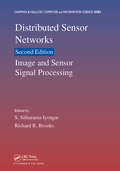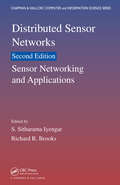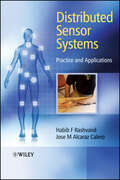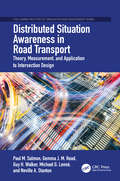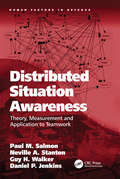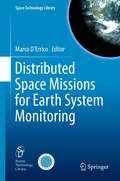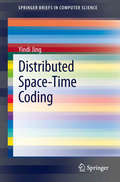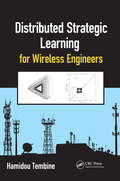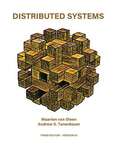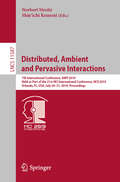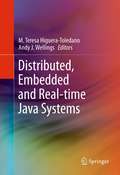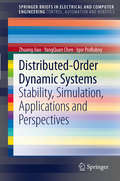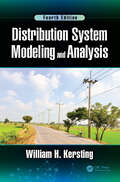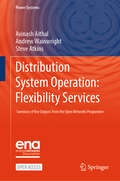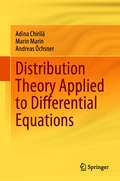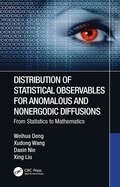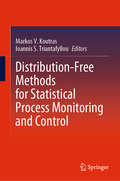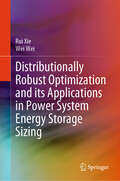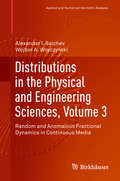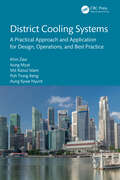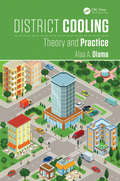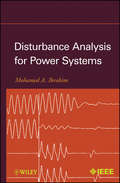- Table View
- List View
Distributed Sensor Networks: Image and Sensor Signal Processing (Volume One) (Chapman And Hall/crc Computer And Information Science Ser. #26)
by S. Sitharama Iyengar Richard R. BrooksThe best-selling Distributed Sensor Networks became the definitive guide to understanding this far-reaching technology. Preserving the excellence and accessibility of its predecessor, Distributed Sensor Networks, Second Edition once again provides all the fundamentals and applications in one complete, self-contained source. Ideal as a tutorial for
Distributed Sensor Networks: Sensor Networking and Applications (Volume Two) (Chapman & Hall/CRC Computer and Information Science Series)
by S. Sitharama Iyengar Richard R. BrooksThe best-selling Distributed Sensor Networks became the definitive guide to understanding this far-reaching technology. Preserving the excellence and accessibility of its predecessor, Distributed Sensor Networks, Second Edition once again provides all the fundamentals and applications in one complete, self-contained source. Ideal as a tutorial for
Distributed Sensor Systems
by Jose M. Alcaraz Calero Habib F. RashvandThis book focuses on the distinct but tightly inter-related areas of development for distributed sensing systemsIn this book, the authors discuss the technological developments lead by sensor technology, addressing viable new applications to inspire a technological evolution. Under the advanced and visionary approach of distributed intelligence, the authors focus on three distinct but tightly inter-related areas of developments for distributed sensing systems (DSS): firstly, the sensor technology embracing the conversion of the phenomena of interest into desirable form of signal such as electric, secondly, the interaction process between sensing points which requires immense intelligence loosely called networking, and finally, the adoption of useful maturing systems through potential applications for right impacts for a better life and a brighter economy. Furthermore, the book contains a number of case studies and typical applications illustrating the technical details, features and functions of the systems, as well as demonstrating their benefits and limitations.Key Features:Discusses the technological developments lead by sensor technologyAddresses viable new applicationsContains a number of case studies and typical applications illustrating the technical details, features and functions of the systemsDemonstrates the benefits and limitations of distributed sensingWritten by experts with vast experience in the field (both in academia and industry)This book will be an invaluable reference for postgraduates studying related courses (communication engineering, engineering management, computer systems, industrial process, automation, design, environmental, urban, surveillance), R&D engineers, system and application designers, researchers, industrial project managers and engineers, and technical and strategic managers planning new products.
Distributed Situation Awareness in Road Transport: Theory, Measurement, and Application to Intersection Design (The Human Factors of Simulation and Assessment Series)
by Paul Salmon Neville Stanton Guy Walker Michael Lenné Gemma ReadHow can we design transport environments that cater to the situation awareness needs of different end-users? This book answers this question by showcasing how state-of-the-art human factors theory and methods can be used to understand how situation awareness differs across drivers, cyclists, motorcyclists, and pedestrians and creates new designs that cater to these diverse situation awareness needs. Written by experts in the field and based on a major program of work funded by the Australian Research Council, this book outlines the distributed situation awareness model and provides practical guidance on how to study situation awareness naturalistically and how to create designs that support, rather than hinder, situation awareness. The book closes by outlining outline a generic framework to support similar applications in other areas, and discusses future applications in areas such as vehicle automation, artificial intelligence, and cybersecurity. Features Challenges traditional road safety analysis, design processes and conventions Outlines a novel on-road study methodology for analyzing naturalistic interactions among drivers, cyclists, motorcyclists and pedestrians Presents a review of state-of-the-art situation awareness theory and methods Provides practical guidance on a series of human factors methods Describes a framework to support the design of transport environments Evaluates new intersection concepts that encompass features designed to prevent collisions at intersections
Distributed Situation Awareness: Theory, Measurement and Application to Teamwork (Human Factors in Defence)
by Daniel P. Jenkins Neville A. Stanton Paul M. SalmonHaving an accurate understanding of what is going on is a key commodity for teams working within military systems. 'Situation awareness' (SA) is the term that is used within human factors circles to describe the level of awareness that operators have of the situation that they are engaged in; it focuses on how operators develop and maintain a sufficient understanding of 'what is going on' in order to achieve success in task performance. Over the past two decades, the construct has become a fundamental theme within the areas of system design and evaluation and has received considerable attention from the human factors research community. Despite this, there is still considerable debate over how SA operates in complex collaborative systems and how SA achievement and maintenance is best supported through system, procedure and interface design. This book focuses on the recently developed concept of distributed situation awareness, which takes a systems perspective on the concept and moves the focus on situation awareness out of the heads of individual operators and on to the overall joint cognitive system consisting of human and technological agents. Situation awareness is viewed as an emergent property of collaborative systems, something that resides in the interaction between elements of the system and not in the heads of individual operators working in that system. The first part of the book presents a comprehensive review and critique of existing SA theory and measurement approaches, following which a novel model for complex collaborative systems, the distributed SA model, and a new modelling procedure, the propositional network approach, are outlined and demonstrated. The next part focuses on real-world applications of the model and modelling procedure, and presents four case studies undertaken in the land warfare, multinational warfare and energy distribution domains. Each case study is described in terms of the domain in question, the methodology employed, and the findings derived in relation to situation awareness theory. The third and final part of the book then concentrates on theoretical development, and uses the academic literature and the findings from the case study applications to validate and extend the distributed SA model described at the beginning of the book. In closing, the utility of the distributed SA model and modeling procedure are outlined and a series of initial guidelines for supporting distributed SA through system design are articulated.
Distributed Space Missions for Earth System Monitoring
by Marco D'ErricoThis title analyzes distributed Earth observation missions from different perspectives. In particular, the issues arising when the payloads are distributed on different satellites are considered from both the theoretical and practical points of view. Moreover, the problems of designing, measuring, and controlling relative trajectories are thoroughly presented in relation to theory and applicable technologies. Then, the technological challenges to design satellites able to support such missions are tackled. An ample and detailed description of missions and studies complements the book subject.
Distributed Space-Time Coding
by Yindi JingDistributed Space-Time Coding (DSTC) is a cooperative relaying scheme that enables high reliability in wireless networks. This brief presents the basic concept of DSTC, its achievable performance, generalizations, code design, and differential use. Recent results on training design and channel estimation for DSTC and the performance of training-based DSTC are also discussed.
Distributed Strategic Learning for Wireless Engineers
by Hamidou TembineAlthough valued for its ability to allow teams to collaborate and foster coalitional behaviors among the participants, game theory’s application to networking systems is not without challenges. Distributed Strategic Learning for Wireless Engineers illuminates the promise of learning in dynamic games as a tool for analyzing network evolution and underlines the potential pitfalls and difficulties likely to be encountered. Establishing the link between several theories, this book demonstrates what is needed to learn strategic interaction in wireless networks under uncertainty, randomness, and time delays. It addresses questions such as: How much information is enough for effective distributed decision making? Is having more information always useful in terms of system performance? What are the individual learning performance bounds under outdated and imperfect measurement? What are the possible dynamics and outcomes if the players adopt different learning patterns? If convergence occurs, what is the convergence time of heterogeneous learning? What are the issues of hybrid learning? How can one develop fast and efficient learning schemes in scenarios where some players have more information than the others? What is the impact of risk-sensitivity in strategic learning systems? How can one construct learning schemes in a dynamic environment in which one of the players do not observe a numerical value of its own-payoffs but only a signal of it? How can one learn "unstable" equilibria and global optima in a fully distributed manner? The book provides an explicit description of how players attempt to learn over time about the game and about the behavior of others. It focuses on finite and infinite systems, where the interplay among the individual adjustments undertaken by the different players generates different learning dynamics, heterogeneous learning, risk-sensitive learning, and hybrid dynamics.
Distributed Systems
by Maarten Van Steen Andrew TanenbaumFor this third edition of "Distributed Systems," the material has been thoroughly revised and extended, integrating principles and paradigms into nine chapters:1. Introduction 2. Architectures 3. Processes 4. Communication 5. Naming 6. Coordination 7. Replication 8. Fault tolerance 9. Security <p><p>A separation has been made between basic material and more specific subjects. The latter have been organized into boxed sections, which may be skipped on first reading. To assist in understanding the more algorithmic parts, example programs in Python have been included. <p><p>The examples in the book leave out many details for readability, but the complete code is available through the book's Website, hosted at www.distributed-systems.net. A personalized digital copy of the book is available for free, as well as a printed version through Amazon.com.
Distributed, Ambient and Pervasive Interactions: 7th International Conference, DAPI 2019, Held as Part of the 21st HCI International Conference, HCII 2019, Orlando, FL, USA, July 26–31, 2019, Proceedings (Lecture Notes in Computer Science #11587)
by Norbert Streitz Shin’ichi KonomiThis book constitutes the refereed proceedings of the 7th International Conference on Distributed, Ambient and Pervasive Interactions, DAPI 2019, held as part of the 21st International Conference on Human-Computer Interaction, HCII 2019, in Orlando, Florida, USA, in July 2019. A total of 1274 papers and 209 posters have been accepted for publication in the HCII 2019 proceedings from a total of 5029 submissions. The 36 papers included in this volume were organized in topical sections on IoT and big data; smart cities and built environments; perception and emotion in DAPI; and DAPI for health and learning.
Distributed, Embedded and Real-time Java Systems
by M. Teresa Higuera-Toledano Andy J. WellingsResearch on real-time Java technology has been prolific over the past decade, leading to a large number of corresponding hardware and software solutions, and frameworks for distributed and embedded real-time Java systems. This book is aimed primarily at researchers in real-time embedded systems, particularly those who wish to understand the current state of the art in using Java in this domain. Much of the work in real-time distributed, embedded and real-time Java has focused on the Real-time Specification for Java (RTSJ) as the underlying base technology, and consequently many of the Chapters in this book address issues with, or solve problems using, this framework. Describes innovative techniques in: scheduling, memory management, quality of service and communication systems supporting real-time Java applications;Includes coverage of multiprocessor embedded systems and parallel programming;Discusses state-of-the-art resource management for embedded systems, including Java's real-time garbage collection and parallel collectors;Considers hardware support for the execution of Java programs including how programs can interact with functional accelerators;Includes coverage of Safety Critical Java for development of safety critical embedded systems.
Distributed-Order Dynamic Systems
by Yangquan Chen Igor Podlubny Zhuang JiaoDistributed-order differential equations, a generalization of fractional calculus, are of increasing importance in many fields of science and engineering from the behaviour of complex dielectric media to the modelling of nonlinear systems. This Brief will broaden the toolbox available to researchers interested in modeling, analysis, control and filtering. It contains contextual material outlining the progression from integer-order, through fractional-order to distributed-order systems. Stability issues are addressed with graphical and numerical results highlighting the fundamental differences between constant-, integer-, and distributed-order treatments. The power of the distributed-order model is demonstrated with work on the stability of noncommensurate-order linear time-invariant systems. Generic applications of the distributed-order operator follow: signal processing and viscoelastic damping of a mass-spring set up. A new general approach to discretization of distributed-order derivatives and integrals is described. The Brief is rounded out with a consideration of likely future research and applications and with a number of MATLAB® codes to reduce repetitive coding tasks and encourage new workers in distributed-order systems.
Distribution Reliability and Power Quality
by Thomas Allen ShortPower distribution and quality remain the key challenges facing the electrical utilities industry. Technology alone cannot provide a solution to power quality problems, and there exists a variety of procedures and programs that can be put in place to ensure reliable, high quality electricity. With chapters carefully culled from the best-selling Electric Power Distribution Handbook, Distribution Reliability and Power Quality provides an economical, sharply focused reference for engineers and technicians working in this specialty area of power distribution.The book introduces the concept of reliability, outlining various methods of assessing and improving reliability along with the factors that affect it. It follows with a detailed look at voltage sags and momentary interruptions, various solutions to these issues, power quality monitoring, and other quality issues such as voltage unbalance and harmonics. Because faults are the cause of many interruptions and other power quality problems, the author devotes a detailed chapter to various aspects of faults. Focused on enhancing the delivery of high-quality power, this volume includes a new chapter on reliability and power quality improvement programs that provide a roadmap to better performance and ultimately to higher efficiency.Presenting a host of practical solutions for reliability and power quality specialists, Distribution Reliability and Power Quality gathers critical tools, techniques, and knowledge into a single source that is ideally suited for immediate implementation.
Distribution System Modeling and Analysis (Fourth Edition)
by William H. KerstingThe latest edition includes new sections on grounded wye–delta short circuit feedback current and simulation of loop flow. The text illustrates methods that ensure the most accurate results in computational modeling for electric power distribution systems. It clearly explains the principles and mathematics behind system models and discusses the "smart grid" concept and its special benefits. Including numerous models of components and several practical examples, the chapters demonstrate how engineers can apply and customize computer programs to help them plan and operate systems. The book also covers approximation methods to help users interpret computer program results, and includes references and assignments that help users apply Mathcad and WindMil programs to put their new learning into practice.
Distribution System Modeling and Analysis with MATLAB® and WindMil®
by William H. Kersting Robert KerestesThis Fifth Edition includes new sections on electric vehicle loads and the impact they have on voltage drop and transformers in distribution systems. A new and improved tape-shield cable model has been developed to produce more accurate impedance modeling of underground cables. In addition, the book uses state-of-the-art software, including the power distribution simulation software Milsoft WindMil® and programming language Mathworks MATLAB®. MATLAB scripts have been developed for all examples in the text, in addition to new MATLAB-based problems at the end of the chapters. This book illustrates methods that ensure the most accurate results in computational modeling for electric power distribution systems. It clearly explains the principles and mathematics behind system models and discusses the smart grid concept and its special benefits. Including numerous models of components and several practical examples, the chapters demonstrate how engineers can apply and customize computer programs to help them plan and operate systems. The book also covers approximation methods to help users interpret computer program results and includes references and assignments that help users apply MATLAB and WindMil programs to put their new learning into practice.
Distribution System Operation: Summary of Key Outputs From the Open Networks Programme (Power Systems)
by Avinash Aithal Andrew Wainwright Steve AtkinsThis open access book is a coherent and accessible source of knowledge on flexibility services for energy. Local flexibility services are a commercial mechanism which allows participants to be renumerated for delivering a change in their usual power use, in real time or in response to prior request from the Distribution System Operators (DSOs) to help manage network congestion. Summarising key outputs from the Energy Networks Association&’s (ENA) Open Networks Programme, the book traces the evolution of local flexibility markets from 'Proof of Concept' to 'Business as Usual'. The book presents detailed technical and organisational insights from the development of local flexibility markets, focusing on inception, standardization, simplification, and transparency in decision-making across GB DSOs and interactions with the National Energy System Operator (NESO). Readers will find valuable comparisons of implementation approaches by different network companies, highlighting technical nuances and best practices. Ideal for researchers, energy professionals, and policymakers, this book provides a critical resource for understanding the complexities and opportunities of flexibility services in energy systems. Whether you are involved in energy management, policy development, or academic research, this book offers essential insights into the future of energy flexibility and grid management.
Distribution Theory Applied to Differential Equations
by Andreas Öchsner Marin Marin Adina ChirilăThis book presents important contributions to modern theories concerning the distribution theory applied to convex analysis (convex functions, functions of lower semicontinuity, the subdifferential of a convex function). The authors prove several basic results in distribution theory and present ordinary differential equations and partial differential equations by providing generalized solutions. In addition, the book deals with Sobolev spaces, which presents aspects related to variation problems, such as the Stokes system, the elasticity system and the plate equation. The authors also include approximate formulations of variation problems, such as the Galerkin method or the finite element method. The book is accessible to all scientists, and it is especially useful for those who use mathematics to solve engineering and physics problems. The authors have avoided concepts and results contained in other books in order to keep the book comprehensive. Furthermore, they do not present concrete simplified models and pay maximal attention to scientific rigor.
Distribution of Statistical Observables for Anomalous and Nonergodic Diffusions: From Statistics to Mathematics
by Xing Liu Xudong Wang Weihua Deng Daxin NieThis book investigates statistical observables for anomalous and nonergodic dynamics, focusing on the dynamical behaviors of particles modelled by non-Brownian stochastic processes in the complex real-world environment. Statistical observables are widely used for anomalous and nonergodic stochastic systems, thus serving as a key to uncover their dynamics. This study explores the cutting edge of anomalous and nonergodic diffusion from the perspectives of mathematics, computer science, statistical and biological physics, and chemistry. With this interdisciplinary approach, multiple physical applications and mathematical issues are discussed, including stochastic and deterministic modelling, analyses of (stochastic) partial differential equations (PDEs), scientific computations and stochastic analyses, etc. Through regularity analysis, numerical scheme design and numerical experiments, the book also derives the governing equations for the probability density function of statistical observables, linking stochastic processes with PDEs. The book will appeal to both researchers of electrical engineering expert in the niche area of statistical observables and stochastic systems and scientists in a broad range of fields interested in anomalous diffusion, especially applied mathematicians and statistical physicists.
Distribution-Free Methods for Statistical Process Monitoring and Control
by Markos V. Koutras Ioannis S. TriantafyllouThis book explores nonparametric statistical process control. It provides an up-to-date overview of nonparametric Shewhart-type univariate control charts, and reviews the recent literature on nonparametric charts, particularly multivariate schemes. Further, it discusses observations tied to the monitored population quantile, focusing on the Shewhart Sign chart. The book also addresses the issue of practically assuming the normality and the independence when a process is statistically monitored, and examines in detail change-point analysis-based distribution-free control charts designed for Phase I applications. Moreover, it introduces six distribution-free EWMA schemes for simultaneously monitoring the location and scale parameters of a univariate continuous process, and establishes two nonparametric Shewhart-type control charts based on order statistics with signaling runs-type rules. Lastly, the book proposes novel and effective method for early disease detection.
Distributionally Robust Optimization and its Applications in Power System Energy Storage Sizing
by Wei Wei Rui XieThis book introduces the mathematical foundations of distributionally robust optimization (DRO) for decision-making problems with ambiguous uncertainties and applies them to tackle the critical challenge of energy storage sizing in renewable-integrated power systems, providing readers with an efficient and reliable approach to analyze and design real-world energy systems with uncertainties. Covering a diverse range of topics, this book starts by exploring the necessity for energy storage in evolving power systems and examining the benefits of employing distributionally robust optimization. Subsequently, the cutting-edge mathematical theory of distributionally robust optimization is presented, including both the general theory and moment-based, KL-divergence, and Wasserstein-metric distributionally robust optimization theories. The techniques are then applied to various practical energy storage sizing scenarios, such as stand-alone microgrids, large-scale renewable power plants, bulk power grids, and multi-carrier energy networks. This book offers clear explanations and accessible guidance to bridge the gap between advanced optimization methods and industrial applications. Its interdisciplinary scope makes the book appealing to researchers, graduate students, and industry professionals working in electrical engineering and operations research, catering to both beginners and experts.
Distributions in the Physical and Engineering Sciences, Volume 3: Random and Anomalous Fractional Dynamics in Continuous Media (Applied and Numerical Harmonic Analysis)
by Alexander I. Saichev Wojbor A. WoyczyńskiContinuing the authors’ multivolume project, this text considers the theory of distributions from an applied perspective, demonstrating how effective a combination of analytic and probabilistic methods can be for solving problems in the physical and engineering sciences. Volume 1 covered foundational topics such as distributional and fractional calculus, the integral transform, and wavelets, and Volume 2 explored linear and nonlinear dynamics in continuous media. With this volume, the scope is extended to the use of distributional tools in the theory of generalized stochastic processes and fields, and in anomalous fractional random dynamics. Chapters cover topics such as probability distributions; generalized stochastic processes, Brownian motion, and the white noise; stochastic differential equations and generalized random fields; Burgers turbulence and passive tracer transport in Burgers flows; and linear, nonlinear, and multiscale anomalous fractional dynamics in continuous media. The needs of the applied-sciences audience are addressed by a careful and rich selection of examples arising in real-life industrial and scientific labs and a thorough discussion of their physical significance. Numerous illustrations generate a better understanding of the core concepts discussed in the text, and a large number of exercises at the end of each chapter expand on these concepts.Distributions in the Physical and Engineering Sciences is intended to fill a gap in the typical undergraduate engineering/physical sciences curricula, and as such it will be a valuable resource for researchers and graduate students working in these areas. The only prerequisites are a three-four semester calculus sequence (including ordinary differential equations, Fourier series, complex variables, and linear algebra), and some probability theory, but basic definitions and facts are covered as needed. An appendix also provides background material concerning the Dirac-delta and other distributions.
District Cooling Systems: A Practical Approach and Application for Design, Operations, and Best Practice
by Aung Myat Md Raisul Islam Khin Zaw Poh Tiong Keng Aung Kywe NyuntThis book draws on the authors’ industry and academic expertise to explain the theory and practice of district cooling systems (DCS). The in-depth exploration of the design and development of DCS presents detailed best practices for their optimization in both the development and operation phases.Readers will gain in-depth practical knowledge on all areas and considerations related to DCS technology's best practices, including current practical research areas and future potential research areas. This book addresses five areas related to DCS: the fundamentals of DCS technology, design optimization for development purposes, real-time optimization for daily operations, techno-commercial decision-making framework, and industry best practice. This information is presented through analyses of technological progress to date; case studies of current operations; and in-depth discussions of the theoretical bases and commercial, technical, and environmental benefits. Through this book, readers can recognize and apply best practices for the design, development, and operation of an optimal DCS design based on multiple factors including financial analysis, energy efficiency considerations, and practical operation issues. This will enable them to contribute to national and international sustainable development goals regarding sustainable cities and climate action.As this book provides both industry know-how and future research directions related to DCS, it is invaluable for DCS industry professionals and advanced undergraduate and postgraduate engineering students who aim to enter this industry and develop leading, highly efficient DCS systems. Overall, it is a vital resource for anyone involved in the planning, execution, and management of DCS projects.
District Cooling: Theory and Practice (Heat Transfer #7)
by Alaa A. OlamaDISTRICT COOLING: THEORY and PRACTICE provides a unique study of an energy cogeneration system, set up to bring chilled water to buildings (offices, apartment houses, and factories) needing cooling for air conditioning and refrigeration. In winter, the source for the cooling can often be sea water, so it is a cheaper resource than using electricity to run compressors for cooling. The related technology of District Heating has been an established engineering practice for many years, but District Cooling is a relatively new technology now being implemented in various parts of the world, including the USA, Arab Emirates and Kuwait, and Saudi Arabia. Existing books in the area are scarce, and do not address many of the crucial issues facing nations with high overall air temperatures, many of which are developing District Cooling plans using sea water. DISTRICT COOLING: THEORY & PRACTICE integrates the theory behind district cooling planning with the practical engineering approaches, so it can serve the policy makers, engineers, and planners whose efforts have to be coordinated and closely managed to make such systems effective and affordable. In times of rising worldwide temperatures, District Cooling is a way to provide needed cooling with energy conservation and sustainability. This book will be the most up-to-date and comprehensive study on the subject, with Case Studies describing real projects in detail.
District Heating and Cooling Networks in the European Union
by Antonio Colmenar-Santos David Borge-Díez Enrique Rosales-AsensioThis book evaluates the potential of the combined use of district heating networks and cogeneration in the European Union (EU). It also proposes measures to remove barriers hindering their widespread implementation, formulates policies for their implementation, and evaluates their economic, energy, and environmental consequences. The book presents a preliminary assessment of the likely cost and the impact of widespread adoption of district heating networks and cogeneration carried out in three cities that represent the variety of climatic conditions in the EU. Based on this assessment, it is estimated that by undertaking the maximum economically feasible implementation across the EU, fuel savings of e95M/year would be achieved, representing energy savings of 6,400 petajoules (PJ), which is around 15% of the total final energy consumption in the EU in 2013 (46,214. 5 PJ). Using simple and quick calculations and not specific software, the method used allows the evaluation of the potential benefits of retrofitting existing power plants into cogeneration plants and connecting them to nearby heating networks. In light of increasing energy costs and environmental concerns, the book is of interest to heating engineers, city planners, and policy-makers around the globe.
Disturbance Analysis for Power Systems
by Mohamed A. IbrahimMore than ninety case studies shed new light on power system phenomena and power system disturbancesBased on the author's four decades of experience, this book enables readers to implement systems in order to monitor and perform comprehensive analyses of power system disturbances. Most importantly, readers will discover the latest strategies and techniques needed to detect and resolve problems that could lead to blackouts to ensure the smooth operation and reliability of any power system.Logically organized, Disturbance Analysis for Power Systems begins with an introduction to the power system disturbance analysis function and its implementation. The book then guides readers through the causes and modes of clearing of phase and ground faults occurring within power systems as well as power system phenomena and their impact on relay system performance. The next series of chapters presents more than ninety actual case studies that demonstrate how protection systems have performed in detecting and isolating power system disturbances in: Generators Transformers Overhead transmission lines Cable transmission line feeders Circuit breaker failuresThroughout these case studies, actual digital fault recording (DFR) records, oscillograms, and numerical relay fault records are presented and analyzed to demonstrate why power system disturbances happen and how the sequence of events are deduced. The final chapter of the book is dedicated to practice problems, encouraging readers to apply what they've learned to perform their own system disturbance analyses.This book makes it possible for engineers, technicians, and power system operators to perform expert power system disturbance analyses using the latest tested and proven methods. Moreover, the book's many cases studies and practice problems make it ideal for students studying power systems.
